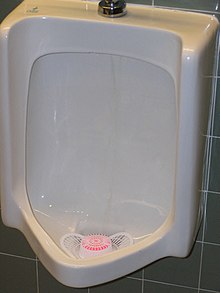Urinal deodorizer block
This article needs additional citations for verification. (April 2024) |


Urinal deodorizer blocks (commonly known as urinal cakes, urinal cookies, urinal biscuits (or jocularly piscuits), urinal donuts, toilet lollies, trough lollies, urinal pucks, hockey pucks, toilet pucks, or urinal peons (alternately urinal pee-ons)) are small disinfectant blocks or tablets that are added to urinals. As these products originally contained para-dichlorobenzene (pDCB) they may also be called para blocks. Besides disinfecting, the purpose of these materials is to deodorize restroom urinals.[1] They are placed above the urinal drain, often in the confines of a small plastic device called a urinal screen that prevents loss down the drain when they dissolve down to a small size.
Chemistry
[edit]
The chemicals composing the block vary. The original formulations were based upon naphthalene and then later para-dichlorobenzene, both now known to be hazardous to health by inhalation. In some areas, the use of para-dichlorobenzene-based blocks has been banned; in other areas para-dichlorobenzene blocks or "para blocks" are still used. [clarification needed] Para-dichlorobenzene- and naphthalene-based blocks do not readily dissolve in water/urine, but easily sublime into the air, creating a sickly-sweet odor that has anti-microbial effects.[2]
Many urinal blocks are now para-dichlorobenzene and naphthalene free; these water-soluble alternative blocks are made from a mixture of fragrances and surfactants (normally quaternary ammonium compounds),[1] which offer some active cleaning and antibacterial efficacy. The new water-soluble blocks improve the cleaning of the pipes which helps to reduce odor. Some recent formulations also include bacterial spores which, coupled with the surfactant cleaning power, can more completely get rid of odors and blockages caused by the buildup of solids in the traps and pipes. Some manufacturers claim that these "biological blocks" can enable completely no-flush waterless urinals to be fitted.
Some urinal blocks also have enzymes added to help digest buildup within pipes.[citation needed]
Autoflush[1] and/or ice are sometimes used as alternatives.[3]
See also
[edit]References
[edit]- ^ a b c "Fact Sheet on Respiratory Hazards and Restroom Deodorant Blocks". INFORM. 2009.
- ^ Rossberg, M.; Lendle, W.; Pfleiderer, G.; Tögel, A.; Dreher, E. L.; Langer, E.; Rassaerts, H.; Kleinschmidt, P.; Strack, H.; Cook, R.; Beck, U.; Lipper, K.-A.; Torkelson, T.R.; Löser, E.; Beutel, K.K.; Mann, T. (2006). "Chlorinated Hydrocarbons". Ullmann's Encyclopedia of Industrial Chemistry. doi:10.1002/14356007.a06_233.pub2. ISBN 3527306730.
- ^ Upton, Chad (31 July 2013). "Why Bars Put Ice in the Urinals". Broken Secrets. Retrieved 31 July 2013.
